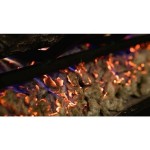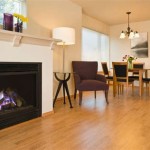Replacing a Gas Fireplace With a Wood Burning Stove: A Comprehensive Guide
Many homeowners consider replacing their existing gas fireplace with a wood-burning stove for various reasons, including the appeal of a more traditional heating source, the desire for greater heating efficiency during power outages, and the aesthetic charm of a wood fire. This transition, however, is a significant undertaking involving careful planning, understanding local regulations, and adherence to safety standards. This article provides a detailed exploration of the process and considerations involved in replacing a gas fireplace with a wood-burning stove.
The first step is to evaluate the existing gas fireplace setup. This includes thoroughly inspecting the fireplace opening, chimney structure, and surrounding area. Consider the existing dimensions of the fireplace, as this will dictate the size and type of wood-burning stove that can be accommodated. Also, assess the condition of the chimney; a chimney that was previously used for a gas fireplace may not be suitable for the higher exhaust temperatures and creosote production associated with wood burning. A professional chimney sweep and inspector can provide a comprehensive assessment of the chimney's structural integrity and suitability for wood-burning appliances.
Local building codes and regulations play a critical role in this replacement process. Before initiating any work, consult with the local municipality to determine the specific permits required for installing a wood-burning stove. These permits typically involve inspections to ensure compliance with safety standards, fire codes, and air quality regulations. Many jurisdictions have restrictions on wood-burning appliances, particularly during periods of high air pollution. Understanding and complying with these regulations is essential to avoid fines and ensure the safe and legal operation of the wood-burning stove.
Key Point 1: Chimney Inspection and Preparation
One of the most crucial aspects of replacing a gas fireplace with a wood-burning stove is the chimney. Gas fireplaces often vent through smaller, less robust chimneys than those required for wood-burning stoves. Wood-burning stoves produce significantly more creosote and higher exhaust temperatures, necessitating a chimney designed to withstand these conditions.
The existing chimney must undergo a thorough inspection to ascertain its condition. This inspection should be performed by a qualified chimney sweep or inspector certified by the Chimney Safety Institute of America (CSIA). The inspector will examine the chimney for cracks, deterioration, and proper flue size. If the existing chimney is deemed inadequate, it may need to be relined or replaced. Relining involves installing a stainless steel liner within the existing chimney to provide a safe and properly sized flue for the wood-burning stove.
The size of the flue is a critical factor in ensuring proper draft and preventing dangerous backdrafting of smoke and combustion gases into the home. The flue size should be compatible with the specifications of the chosen wood-burning stove, as indicated by the manufacturer. An undersized flue can lead to poor combustion, excessive smoke, and increased creosote buildup, while an oversized flue can result in insufficient draft and inefficient heating.
If the existing chimney is masonry, it should be inspected for cracks and deterioration. Mortar joints should be solid, and the brick or stone should be in good condition. Any necessary repairs should be completed before installing the wood-burning stove. Also, ensure that the chimney meets the required height above the roofline, as specified in local building codes. This height is crucial for proper draft and to prevent downdrafts that can force smoke back into the house.
Key Point 2: Selecting the Right Wood Burning Stove
Choosing the appropriate wood-burning stove is pivotal for both safety and heating efficiency. Several factors influence this decision, including the size of the area to be heated, the stove's heating capacity (measured in BTUs), and the stove's emissions rating. Wood-burning stoves are available in various sizes and styles, ranging from small, decorative models to large, high-output stoves designed for heating larger homes.
The heating capacity of the stove should be matched to the size of the space it is intended to heat. A stove that is too small will struggle to maintain a comfortable temperature, while a stove that is too large can overheat the room and waste fuel. Consult with a qualified stove retailer or installer to determine the appropriate BTU output for the intended application. They can assess factors such as the room's insulation levels, window size, and climate to recommend a suitable stove.
Emissions ratings are another important consideration. The Environmental Protection Agency (EPA) regulates wood-burning stoves to reduce particulate matter emissions and improve air quality. EPA-certified stoves are significantly cleaner-burning than older, non-certified models. When selecting a wood-burning stove, prioritize models that meet the latest EPA emissions standards. These stoves not only reduce air pollution but also burn more efficiently, saving fuel and reducing creosote buildup.
Beyond performance, the stove's style and features are also important. Consider the aesthetic appeal of the stove and how it will complement the existing décor. Features such as a glass door, air wash system, and catalytic combustor can enhance the functionality and ease of use of the stove. A glass door allows for viewing the fire, while an air wash system helps keep the glass clean. A catalytic combustor reduces emissions and improves the stove's efficiency.
Key Point 3: Installation and Safety Considerations
The installation of a wood-burning stove is a complex process that should ideally be performed by a qualified and certified installer. Proper installation is critical for safety and performance. Incorrect installation can lead to fire hazards, carbon monoxide poisoning, and inefficient heating.
Before installation, carefully review the manufacturer's instructions for the chosen stove. These instructions provide detailed guidance on clearances to combustible materials, floor protection requirements, and chimney connection procedures. Adhering to these clearances is essential to prevent fires. Combustible materials, such as walls, furniture, and curtains, must be kept a safe distance from the stove to avoid overheating and ignition.
Floor protection is another critical safety measure. Wood-burning stoves can produce radiant heat that can ignite combustible flooring materials. Most building codes require a non-combustible floor protector beneath the stove and extending a specified distance in front of the stove. This floor protector can be made of materials such as brick, stone, tile, or specially designed stove boards.
Connecting the stove to the chimney requires careful attention to detail. The stove pipe must be properly sized and securely connected to both the stove and the chimney. All connections should be airtight to prevent smoke and combustion gases from escaping into the house. Use appropriate sealant and fasteners to ensure a secure and leak-free connection.
Carbon monoxide (CO) detectors are essential safety devices for any home with a wood-burning stove. CO is a colorless, odorless gas that can be deadly. Install CO detectors on each level of the home, particularly near sleeping areas. Test the detectors regularly to ensure they are functioning properly. Additionally, maintain a working smoke detector on each level of the home.
Proper ventilation is crucial for safe and efficient operation. Ensure that the room where the stove is located has adequate ventilation to provide fresh air for combustion. Insufficient ventilation can lead to incomplete combustion, increased creosote buildup, and carbon monoxide production. In some cases, it may be necessary to install a dedicated air intake to supply fresh air to the stove.
Regular maintenance is essential for the safe and efficient operation of a wood-burning stove. The chimney should be inspected and cleaned annually by a qualified chimney sweep to remove creosote buildup. Creosote is a highly flammable substance that can accumulate in the chimney and cause a chimney fire. The stove itself should also be inspected regularly for any signs of wear or damage. Replace any worn or damaged parts promptly.
Finally, proper wood storage and handling are crucial for preventing fire hazards and ensuring efficient combustion. Store firewood in a dry, well-ventilated area away from the house. Avoid storing firewood indoors, as this can attract pests and increase the risk of insect infestation. Only burn seasoned firewood, which has been dried for at least six months. Seasoned wood burns cleaner and more efficiently than green wood, producing less smoke and creosote.
Replacing a gas fireplace with a wood-burning stove is a complex project with numerous considerations. Careful planning, adherence to local regulations, and prioritizing safety are essential for a successful and safe installation. By thoroughly inspecting the chimney, selecting the right stove, and following proper installation procedures, homeowners can enjoy the warmth and ambiance of a wood-burning stove while ensuring the safety of their home and family.

Replacing A Gas Fire With Wood Burner

Do You Want To Replace Your Gas Fire With A Woodburner

Do You Want To Replace Your Gas Fire With A Woodburner

Converting A Fireplace To Wood Burning Stove Chesneys

Replacing A Wood Burning Stove With Gas Simon Turner Showrooms In Devon

Is It Time To Replace Your Old Gas Fire For A More Efficient Wood Burning Stove Alfred Poppins

Converting A Fireplace To Wood Burning Stove Chesneys

Want To Convert Gas Wood Fireplace Full Service Chimney

Replace Gas Fire With Woodburner In North Petherton Cosy Stoves

Can I Swap A Gas Fire For Woodburner
Related Posts








